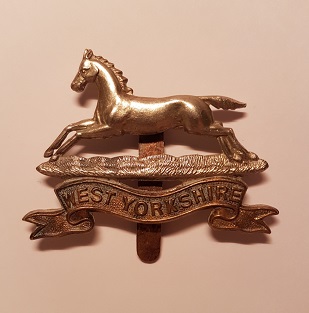Lieutenant-General Sir Harold Bridgwood Walker, was a senior British Army commander who led Australian and New Zealand forces for much of the First World War. He was highly regarded by the men he commanded and was only replaced in 1918 when politics dictated that all divisions of the Australian Imperial Force should be commanded by Australians.

The West Yorkshire Regiment (Prince of Wales's Own) (14th Foot) was an infantry regiment of the British Army. In 1958 it amalgamated with the East Yorkshire Regiment (15th Foot) to form the Prince of Wales's Own Regiment of Yorkshire which was, on 6 June 2006, amalgamated with the Green Howards and the Duke of Wellington's Regiment (West Riding) to form the Yorkshire Regiment (14th/15th, 19th and 33rd/76th Foot).

The Somerset Light Infantry (Prince Albert's) was a light infantry regiment of the British Army, which served under various titles from 1685 to 1959. In 1959, the regiment was amalgamated with the Duke of Cornwall's Light Infantry to form the Somerset and Cornwall Light Infantry which was again amalgamated, in 1968, with the King's Own Yorkshire Light Infantry, the King's Shropshire Light Infantry and the Durham Light Infantry to form The Light Infantry. In 2007, however, The Light Infantry was amalgamated further with the Devonshire and Dorset Regiment, the Royal Gloucestershire, Berkshire and Wiltshire Regiment and the Royal Green Jackets to form The Rifles.

The King's Own Yorkshire Light Infantry (KOYLI) was a light infantry regiment of the British Army. It officially existed from 1881 to 1968, but its predecessors go back to 1755. In 1968, the regiment was amalgamated with the Somerset and Cornwall Light Infantry, the King's Shropshire Light Infantry and the Durham Light Infantry to form The Light Infantry, which in turn was merged with the Devonshire and Dorset Regiment, the Royal Gloucestershire, Berkshire and Wiltshire Regiment and the Royal Green Jackets to become The Rifles in 2007.

The Devonshire Regiment was a line infantry regiment of the British Army that served under various titles and served in many wars and conflicts from 1685 to 1958, such as the Second Boer War, the First World War and the Second World War. In 1958 the regiment was amalgamated with the Dorset Regiment to form the Devonshire and Dorset Regiment which, in 2007, was amalgamated with the Royal Gloucestershire, Berkshire and Wiltshire Regiment, the Royal Green Jackets and The Light Infantry to form a new large regiment, The Rifles.
Major-General Sir Borlase Elward Wyndham Childs was a British Army officer who also served as Assistant Commissioner of Police of the Metropolis from 1921 to 1928.

General Sir Charles Harington Harington, was a British Army officer most noted for his service during the First World War and the Chanak Crisis. During his 46 years in the army, Harington served in the Second Boer War, held various staff positions during the First World War, served as Deputy Chief of the Imperial General Staff between 1918 and 1920, commanded the occupation forces in the Black Sea and Turkey, and ultimately became Governor of Gibraltar in 1933.

The Duke of Cornwall's Light Infantry (DCLI) was a light infantry regiment of the British Army in existence from 1881 to 1959.

Lieutenant General Sir Charles Edmond Knox, KCB was an Anglo-Irish soldier of the British Army.

Major-General Sir Charles St Leger Barter, (1857–1931) was a career British Army officer.
Major General Sir Charles Edward Corkran, was a senior British Army officer who served as Major-General commanding the Brigade of Guards and General Officer Commanding London District from 1928 to 1932.
General Sir Charles Bonham-Carter, was a British Army officer and later Governor of Malta.

Lieutenant-General Sir William Penn Symons KCB was a British Army officer who was mortally wounded as he commanded his forces at the Battle of Talana Hill during the Second Boer War. While his forces won the battle, they had to abandon their position and fall back to Ladysmith. Symons and the more severely wounded were left to the Boers; he died three days later as a prisoner of war. A monument to his valour was raised in Victoria Park, Saltash, Cornwall, UK.

The 2nd Royal Cheshire Militia was a militia infantry battalion raised in Macclesfield, Cheshire, England in 1853. Later linked to the regular Cheshire Regiment as its 4th (Militia) Battalion, the unit served in the Second Anglo-Boer War before disbandment in 1908.

Lieutenant-General Sir Reginald Pole-Carew, was a British Army officer who became General Officer Commanding 8th Division.
Brigadier General William Denman Croft, was a British Army officer. He served as a brigadier general in the British Army in the First World War, and afterwards in India. He was one of seven British officers to be awarded the Distinguished Service Order four times in the First World War. He was Home Guard commander in Cornwall during the Second World War.

General Sir Henry Edward ap Rhys Pryce, KCB, CMG, DSO was a Welsh officer in the Indian Army who served Master-General of the Ordnance in British India.

The Rangers was a volunteer unit of the British Army, originally formed in 1860. It provided a detachment for service in the Second Boer War, saw intensive action on the Western Front in the First World War, and served as motorised infantry during the Second World War during the campaigns in Greece and the Western Desert.
Major-General Sir Charles Patrick Amyatt Hull, was a senior British Army officer who served during the Second Boer War and World War I. He was the father of Field Marshal Sir Richard Hull and the grandfather of Lieutenant General Richard Swinburn.
Brigadier-General John Townshend St Aubyn, 2nd Baron St Levan,, known as Hon. John Townshend St Aubyn from 1866 to 1908, was a British army officer and peer.












